Science Overview
Introduction
 |
|
Artists impression of Ulysses |
Other investigations are directed towards studies of cosmic dust and interstellar neutral gas, as well as solar x-rays and cosmic gamma-ray bursts. Radio science experiments to probe the solar corona and to conduct a search for gravitational waves have also been carried out.
In addition to its own unique observations, Ulysses also plays a key role in the network of heliospheric spacecraft that includes SOHO, Wind, ACE, Voyager, Solar-B, STEREO and the upcoming SDO mission.
Heliosphere
If you could leave the Earth and travel vertically through its atmosphere, you may expect eventually to reach empty space - a void of darkness where nothing exists. The space around the Earth, however, is far from empty. The solar wind, charged particles (electrons and ions) streaming away from the Sun, envelops our planet and its neighbours. It blows a magnetic bubble out into the region of interstellar space surrounding the Sun. This bubble is called the heliosphere ("Helios" is the ancient Greek word for "Sun"). It defines the volume of space over which our Sun's influence predominates.
That influence reaches way beyond what we normally think of as the solar system. The closest boundary of the heliosphere is thought to extend about 100 AU out from the Sun, that is 100 times the distance of the Earth from the Sun and at least twice as far out as the Kuiper belt, which contains the most distant objects in the solar system. NASA's two Voyager spacecraft are expected to reach this boundary before they finally grow too old to transmit signals in about 2020.
The heliosphere acts as a shield, protecting us from the bulk of cosmic rays, very energetic particles generated far away in the universe that would otherwise bombard the Earth continuously, causing damage to living cells. Without the heliosphere, life would certainly have evolved differently - and maybe not at all.
The Sun is not the only star to form a heliosphere. Stellar winds are thought to be common and there is firm evidence for "asterospheres" surrounding several of our closest stellar neighbours, including Sirius and Alpha Centauri.
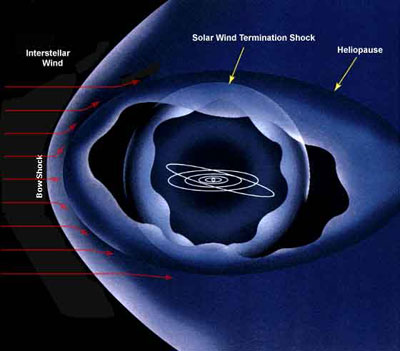 |
|
Schematic of the heliosphere, showing the boundary regions between the heliosphere and the interstellar medium. Credit: NASA. |
Solar Wind
The existence of the solar wind was first put forward by Ludwig Biermann in 1951, who suggested that comet tails are always directed away from the Sun because they are pushed by a continuous flow of charged particles streaming out from the Sun. It was already known that the Sun's atmosphere, or corona, is very hot - a million degrees or more - and in 1957 Sydney Chapman showed that it should extend far out into space. One year later, Eugene Parker, the "father" of solar wind science, proposed that this hot corona not only extends far into space, but escapes the Sun's gravity as a "supersonic" wind, dragging the solar magnetic field with it as it expands. His ideas were greeted with scepticism initially, but supporting evidence soon followed from space probes like Mariner 2.
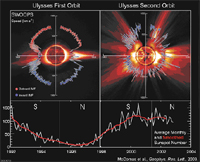 |
|
Solar Wind speed measured by |
Instruments
Four instruments on Ulysses measure the magnetized solar wind:
- SWOOPS (Solar Wind Observations Over the Poles of the Sun)
- SWICS (Solar Wind Ion Composition Spectrometer)
- URAP (Unified Radio and Plasma Wave experiment)
- MAG (Vector Helium and Flux Gate Magnetometers)
SWOOPS (Solar Wind Observations Over the Poles of the Sun)
SWOOPS measures the basic characteristics of the solar wind plasma with two sensors, one for ions (mainly protons and helium ions), and one for electrons. These sensors provide data on the flow speed and direction, the density, and the temperature of the solar wind.
SWICS (Solar Wind Ion Composition Spectrometer)
SWICS measures the elemental and ionic-charge composition, temperature, and mean speed of all major solar wind ions. The abundance ratios of the different ionization states of solar wind ions like oxygen (e.g., O6+/O7+) are being used as a highly effective tool to infer the temperature in the corona from which a given solar wind stream originates.
URAP (Unified Radio and Plasma Wave experiment)
URAP detects a wide variety of natural radio sources originating at the Sun, the heliosphere, and in the magnetospheres of Jupiter and Saturn. The characteristics of the radio signals generated in the vicinity of the spacecraft are being used to infer the solar wind electron density and temperature from URAP data. URAP is also able to track solar wind disturbances (coronal mass ejections, or CMEs) as they move through interplanetary space.
MAG (Vector Helium and Flux Gate MAGnetometers)
The two MAG sensors measure the strength and direction of the heliospheric magnetic field that is carried away from the Sun by the solar wind.
Energetic Charged Particles
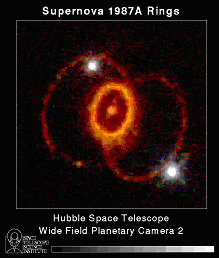 |
|
Image of a supernova made by the Hubble Space Telescope. Supernova explosions are thought to be the sites of cosmic ray acceleration. |
Space scientists use the term "energetic charged particles" to describe ions and electrons that have gained enough energy to move through space at a reasonable fraction of the speed of light. Because they carry an electrical charge, energetic charged particles are constrained to move along the lines of force of the magnetic fields in space. In the Earth's magnetosphere, energetic particles trapped in the Earth's magnetic field form the radiation belts. In the heliosphere, the majority of energetic particles are accelerated near the Sun in solar flares or at shock waves driven by CMEs. These are often called Solar Energetic Particles, and can have energies as high as 1 billion electron volts (1 GeV). For comparison, electrons in a TV tube are accelerated to 30 thousand electron volts.
The highest energy charged particles are Galactic Cosmic Rays, completely ionized atomic nuclei originating outside the heliosphere. Representing a true sample of extra solar-system material, GCRs are thought to be accelerated to very high energies in explosions of distant stars. By studying the composition of cosmic ray nuclei, we can learn a great deal about the way our galaxy and stars like the Sun have evolved.
Instruments
Four instruments on Ulysses make measurements of energetic charged particles:
- HI-SCALE (Heliosphere Instrument for Spectra, Composition and Anisotropies at Low Energies)
- EPAC (Energetic Particle Composition experiment)
- COSPIN (Cosmic Ray and Solar Particle Investigation)
- URAP (Unified Radio and Plasma Wave experiment)
HI-SCALE (Heliosphere Instrument for Spectra, Composition and Anisotropies at Low Energies)
HI-SCALE measures the composition and arrival directions of low-energy electrons and ions using five separate sensor heads to cover all viewing directions.
EPAC (Energetic PArticle Composition experiment)
EPAC measures the composition and arrival directions of low-energy ions using four separate sensor heads to cover all viewing directions.
COSPIN (COsmic Ray and Solar Particle INvestigation)
COSPIN measures solar energetic particle and cosmic ray electrons and ions over a wide range of energies, using five separate sensors. One of these, the High Energy Telescope (HET), is making the most precise determination to date of cosmic ray isotopic composition.
URAP (Unified Radio And Plasma Wave experiment)
Although not a particle detector in the traditional sense, URAP can provide data on energetic electrons emitted from solar flares by sensing the radio emission they generate while streaming away from the Sun along the heliospheric magnetic field lines.
Interstellar Gas and Dust
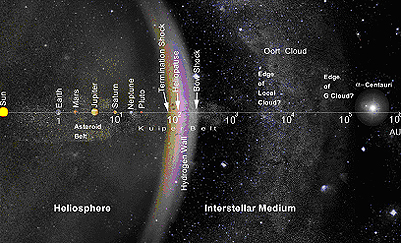 |
|
Schematic showing the characteristic distances in the heliosphere and local interstellar medium on a logarithmic scale, measured in Astronomical Units (AU). 1 AU = 150 million km. |
As the strength and level of solar activity varies in time, so does the size and behaviour of the heliosphere. It would probably extend outwards from the Sun indefinitely if the solar wind did not come up against a barrier, a conflicting stream of charged particles coming from interstellar space. The solar system is at the edge of an interstellar cloud that is moving independently of the rotation of the Milky Way galaxy. The solar wind is brought to a halt when the pressure of its outward flow is matched by that exerted by the local interstellar medium (LISM).
Because the solar wind is magnetized, its presence is felt by all charged particles, making it difficult for them to enter the heliosphere. To the neutral atoms that make up a significant part of the local interstellar cloud, however, the solar wind is largely invisible. Affected only by gravity and the pressure of sunlight, many of these neutrals are able to penetrate far into the heliosphere before finally interacting with a charged particle in the solar wind and becoming ionized by losing an electron. They then start a new life as so-called "pick-up ions", becoming embedded in the expanding solar wind. Measurements of interstellar gas, either directly as neutral atoms, or indirectly as pick-up ions, can provide information about the LISM surrounding the heliosphere, as well as conditions at the boundary itself.
Once they have been converted into pick-up ions, interstellar gas atoms can take on a third identity, masquerading as cosmic rays. The pick-up ions interact with the termination shock, which acts as a huge accelerator. They then travel back towards the Sun, mimicking galactic cosmic rays.
They have been given the name "anomalous" cosmic rays. Ulysses has made the first ever direct measurement of neutral helium and extensive measurements of a wide range of previously undetected pick-up ions. With these observations, scientists have been able to identify the particular local interstellar cloud in which the Sun resides.
Instruments
The following instruments on Ulysses make measurements of interstellar gas and dust:
- GAS (Interstellar Neutral Helium experiment)
- DUST (Cosmic Dust experiment)
- SWICS (Solar Wind Ion Composition Spectrometer)
The following instruments on Ulysses measure Anomalous Cosmic Rays:
- HI-SCALE (Heliosphere Instrument for Spectra, Composition and Anisotropies at Low Energies)
- EPAC (Energetic Particle Composition experiment)
- COSPIN (Cosmic Ray and Solar Particle Investigation)
GAS (Interstellar Neutral Helium GAS experiment)
GAS is a new instrument, flown for the first time in space on board Ulysses. It detects interstellar neutral helium atoms that penetrates the heliosphere, and measures the flow speed, the temperature, and density of the gas.
DUST (Cosmic DUST experiment)
The DUST experiment measures the mass and arrival direction of dust particles of interplanetary and interstellar origin. DUST discovered the presence of interstellar dust grains in the inner heliosphere.
SWICS (Solar Wind Ion Composition Spectrometer)
In addition to solar wind ions, SWICS measures the elemental and ionic-charge composition, temperature, and mean speed of interstellar pick-up ions. The pick-up ion data are being used to infer the composition of interstellar gas elements that are otherwise inaccessible.
Cosmic Gamma-Ray Bursts
Cosmic gamma-ray bursts are the most powerful explosions in the known universe. They appear to be generated by the collapse of very massive stars (~100 solar masses). The distances to about a dozen sources have now been measured, showing that they are at cosmological distances comparable to those of quasars. If the bursts emit their energy uniformly into space, their output is 1053 erg in gamma-rays alone. In addition to being interesting in their own right, gamma-ray bursts are being used by cosmologists as probes of the early universe.
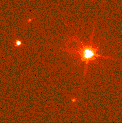 |
Hubble Space Telescope STIS image of the host galaxy (the bright source on the left in this 10×10" view) where the gamma-ray burst GRB 000301C of 1 March 2000 originated. The burst came from a distance of 11 billion light-years. Ulysses and the Rossi X-Ray Timing Explorer determined its position. |
Instruments
There is one instrument on board Ulysses dedicated to measurements of the cosmic gamma-ray bursts:
GRB (Gamma-Ray Burst detector)
GRB is a key member of the 3rd Interplanetary Network (IPN) of gamma-ray burst detectors, which locates bursts precisely by comparing their arrival times at widely separated spacecraft. In the course of studying gamma-ray bursts, GRB has played a major role in the study of so-called soft gamma repeaters, or magnetars.
Radio Science
Two scientific investigations have been carried out using the Ulysses spacecraft's dual-frequency (X- and S-band) radio communications link with the Earth:
- SCE (Solar Coronal-Sounding Experiment)
- GWE (Gravitational Wave Experiment)
SCE (Solar Coronal-Sounding Experiment)
The main goal of the SCE radio science experiment was to measure the electron content (column density), and its variations, of the near-Sun corona using radio sounding techniques. This experiment was conducted on two occasions, during the first solar conjunction (C1) of the Ulysses mission in the summer of 1991, and again during the fourth solar conjunction (C4) in the winter of 1995. In addition, radio sounding of the Io Plasma Torus was carried out during the Jupiter fly-by in 1992.
GWE (Gravitational Wave Experiment)
The GWE was an attempt to detect, for the first time, low-frequency (mHz) gravitational waves crossing the solar system. Potential sources of such gravitational waves include astrophysical objects such as binary black holes, supernovae, quasars, and active galactic nuclei. The data did not lead to a positive identification of gravitational waves.
